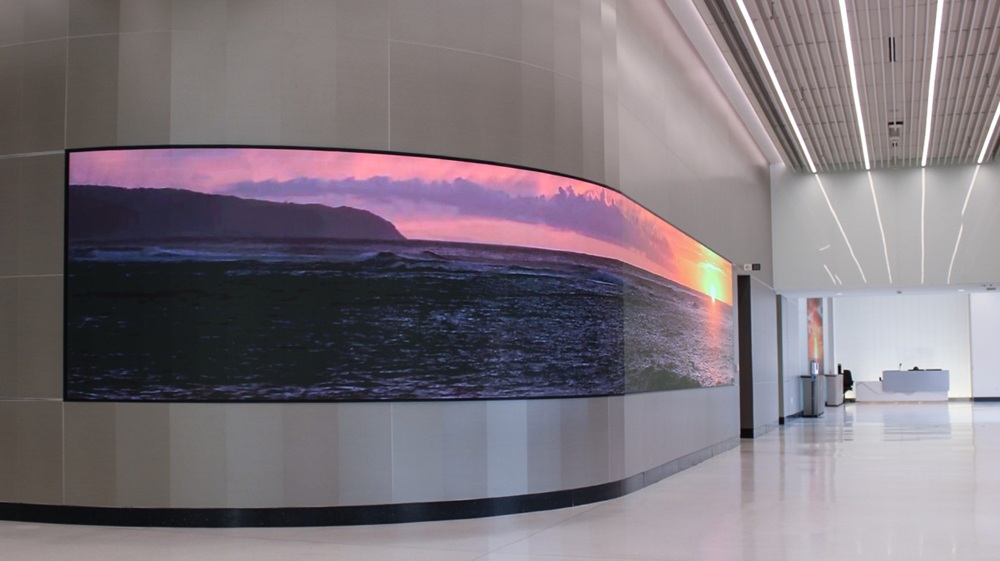Indoor LED displays have transformed how businesses, event organizers, and venues communicate and interact with their audiences. Valued for their dynamic visuals and flexibility, these displays are widely used in shopping malls, conference halls, airports, entertainment venues, and corporate offices. This article explores the appeal, advantages, applications, and current trends of indoor LED displays.
1. What is an Indoor LED Display?
An indoor LED display is a high-resolution screen that uses light-emitting diodes (LEDs) to present images and videos. Unlike traditional display technologies such as LCDs, LED screens offer higher brightness and color contrast, producing sharper, more vivid content. An “LED display” generally refers to a digital screen made up of many small LED pixels that change color to render high-quality visuals.
Indoor LED displays are designed specifically for indoor environments, where they are not exposed to direct sunlight, rain, or other outdoor elements. Compared to outdoor screens, indoor LED displays typically require lower brightness while offering a wider range of colors. These displays come in various shapes, resolutions, and pixel pitches, allowing clients to select the configuration that best meets their needs.
2. How Do Indoor LED Displays Work?
Indoor LED displays consist of thousands of LED lights arranged in a panel framework. Each LED acts as a pixel and combines red, green, and blue (RGB) subpixels to create multiple colors. The closer the LEDs are to each other, the higher the pixel density (or smaller the pixel pitch), resulting in finer, sharper images.
These screens use a modular design, meaning smaller panels can be assembled into larger displays without compromising image quality. This modularity also makes maintenance easier, as individual panels can be repaired or replaced instead of the entire screen.
A video controller or processor converts video signals into information that the LED display can show. The controller determines how each LED should operate based on the incoming video, ensuring real-time accuracy in color, brightness, and clarity.
3. Advantages of Indoor LED Displays
-
High Brightness and Contrast: LED displays deliver intense brightness and strong contrast, making them ideal for well-lit spaces such as shopping centers, airports, and office lobbies.
-
Excellent Color Accuracy: Indoor LED screens can display millions of colors, providing realistic images and dynamic visuals. RGB technology ensures precise color mixing, guaranteeing high-quality visuals for images, text, and videos.
-
Modular Design: LED panels offer flexibility in size and shape, suitable for everything from small retail displays to large cultural center screens.
-
Wide Viewing Angles: LED displays maintain image clarity from multiple viewing angles, ensuring audiences can see content clearly from various positions.
-
Energy Efficiency: LEDs consume less power than traditional LCD or plasma screens, making them an environmentally friendly option for long-term use.
-
Long Lifespan and Durability: Indoor LEDs can operate for thousands of hours with minimal brightness loss, making them a cost-effective investment.
-
Seamless Integration: LED displays can easily sync with digital systems for dynamic content, live streaming, smart features, and multi-device coordination.
4. Applications of Indoor LED Displays
Indoor LED displays are popular across a variety of sectors due to their versatility:
-
Retail: Retailers use LED screens to attract customers, showcase products, and create interactive shopping experiences. Digital signage enhances the store’s visual appeal and modernity.
-
Corporate Offices: Many businesses install LED displays in lobbies, meeting rooms, and office spaces for presentations, video conferencing, and digital signage, improving communication and creating a tech-savvy environment.
-
Events: Trade shows, concerts, performances, and corporate events benefit from LED displays, which provide immersive visuals and can serve as stunning backdrops.
-
Education and Training: Universities, training centers, and conference venues use LED displays for instructional content, presentations, and real-time information, improving engagement and learning outcomes.
-
Airports and Transportation Hubs: LED displays are used to show travel information, weather updates, and advertisements. Their high brightness ensures visibility even in well-lit, crowded areas.
-
Entertainment and Sports: Theaters, stadiums, and sports arenas use indoor LED screens for live events, highlights, and announcements, creating exciting, visually engaging experiences.
5. Key Features to Consider
-
Pixel Pitch: Smaller pixel pitch means higher pixel density and sharper images. For indoor use, a 2–4mm pixel pitch is typical for close viewing.
-
Brightness and Contrast: The screen should be bright enough to overcome ambient lighting without causing discomfort. Adjustable brightness of 500–1000 nits is recommended for indoor applications.
-
Refresh Rate: High refresh rates (1000Hz or higher) ensure smooth video playback and eliminate flickering.
-
Viewing Angles: Wide viewing angles ensure clear visibility from different positions without color distortion.
-
Color Accuracy: Critical for applications requiring precise visuals, such as product displays or presentations.
-
Maintenance and Accessibility: Modular panels with open access facilitate easy repairs and replacements.
-
Durability and Lifespan: Choose screens rated for long-term operation (50,000 hours or more) without overheating or brightness reduction.
6. Emerging Trends in Indoor LED Displays
-
MicroLED Innovation: Smaller LEDs allow higher pixel density and improved image quality, ideal for ultra-high-resolution applications.
-
4K and 8K Resolution: Increasing demand for higher resolutions drives the adoption of 4K and 8K indoor LED displays, enhancing immersive experiences.
-
Interactive Displays: Touch and sensor integration enables audience interaction, useful in education, retail, and meeting spaces.
-
Curved and Adaptive Screens: Flexible screens allow creative installations, such as wrapping around pillars or forming immersive curved walls.
-
HDR Technology: High Dynamic Range delivers richer colors and superior contrast for immersive visuals.
-
Cloud-Based Content Management: Remote content control simplifies updates across multiple locations.
-
Energy Efficiency Improvements: Advances in LED technology reduce energy consumption, lowering operational costs for businesses.
-
AR Integration: Augmented reality combined with LED displays offers immersive experiences blending the digital and physical worlds.
7. Installation and Support Considerations
-
Placement: Ensure visibility and engagement by positioning displays at eye level in high-traffic areas.
-
Ventilation and Cooling: Proper airflow prevents overheating, preserving screen lifespan and image quality.
-
Calibration: Regular calibration maintains color accuracy and brightness consistency.
-
Cleaning: Routine cleaning prevents dust accumulation that could affect image quality.
8. Tips to Maximize Indoor LED Display Impact
-
Optimize Content: Use high-contrast images, clear text, and vibrant colors suitable for LED screens.
-
Leverage Video and Motion Graphics: Dynamic content engages viewers and highlights products effectively.
-
Consider Audience Placement: Strategically position displays to capture attention in key areas.
-
Integrate Real-Time Data: Weather, news, or sales data enhance relevance.
-
Encourage Interaction: Touch and sensor features increase engagement.
-
Align Content with Brand: Ensure visuals match brand identity and aesthetics.
-
Integrate Social Media: Display live social content to boost interaction.
-
Regularly Update Content: Keep displays fresh to maintain audience interest.
9. Conclusion: The Impact of Indoor LED Displays
Indoor LED display screen have become a vital communication tool, offering a dynamic platform for businesses and institutions to engage audiences. With high-quality visuals, flexibility, and energy efficiency, LED screens are poised to become an integral part of modern life.
Advances in AI-driven content, smart displays, and energy-efficient technology will continue to shape the industry. Investing in indoor LED displays is not just purchasing a screen—it is creating a versatile visual communication hub. By staying up-to-date with trends and optimizing usage, businesses can maximize the value of this powerful medium. As digital experiences become increasingly immersive and personalized, indoor LED displays will play a crucial role in the future of visual interaction.
Post time: Nov-05-2025



